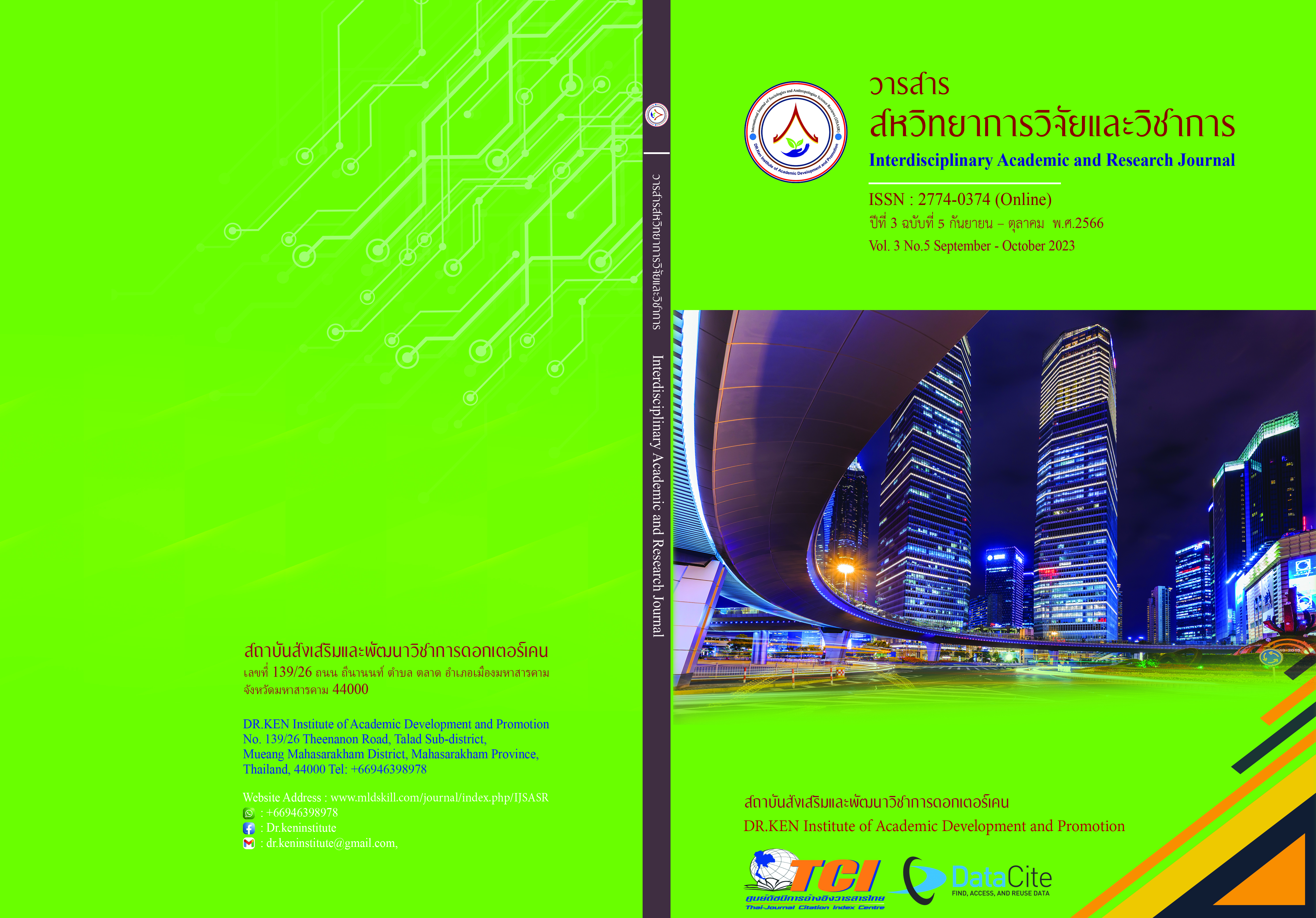The Effects of Folk Dance Activity Provision on Cultural Identity in Young Children
DOI:
https://doi.org/10.14456/iarj.2023.237Keywords:
Folk Dance; , Cultural Identity;, Young ChildrenAbstract
At present, children are focusing much of their attention on foreign cultures, including food, costumes, language, music, and symbolic expressions. The imitation of foreign film stars and singers has influenced their culture and resulted in changes in their lives. Because of this, some of these children do not dare to express an interest in the beauty of Thai culture. It is vital to provide young children with both a foundation of cultural knowledge and a sense of cultural awareness so that they will preserve the unique cultural characteristics of their province. The purpose of this study was to study the effects of folk-dance activity provision on cultural identity in young children. The target group was 25 of 4-5 years old, studying in K2, the 2nd semester, the academic year of 2022, at Anubalwatangthong School. The research instruments used in the study were 24 lesson plans on folk dance activities provision for young children and an assessment form on cultural identity in young children. Data was analyzed by using mean, standard deviation, and content analysis. The results showed that young children who participated in the folk dance activity provision had higher pretest scores than the posttest ones. The children could tell that farming was the main occupation of the local people. The longest drum in Angthong province is famous and the longest in the world. There is local wood weaving into wickerwork resulting in the local wisdom that creates a career and reputation for the local area. The children were delighted and excited to dance in their own local folk dances. They admired the folk-dance props such as long drums and wickerwork. They could tell that basketry is the local wisdom of people in Ang Thong province.
References
กาญจนา แก้วเทพ, (2552), การสังเคราะห์องค์ความรู้เรื่องการใช้และการเสริมความเข้มแข็งแก่การสื่อสารเพื่อการพัฒนาชุมชน. คณะนิเทศศาสตร์ จุฬาลงกรณ์มหาวิทยาลัย.
กุลยา ตันติผลาชีวะ. (2547). การจัดกิจกรรมการเรียนรู้สำหรับเด็กปฐมวัย. กรุงเทพฯ: เอดิสันเพรสโปรดักส์.
โกวิทย์ ขันธศิร. (2527). สื่อการสอนดนตรีและนาฎศิลป์ในสื่อการสอนระดับประถมศึกษา. เล่ม 1 หน่วยที่ 8 สาขาศึกษาศาสตร์. กรุงเทพฯ : มหาวิทยาลัยสุโขทัยธรรมาธิราช.
ชัยวัฒน์ บวรวัฒนเศรษฐ์. (2559). ยุทธศาสตร์การจัดการเรียนการสอนตามทฤษฎี การเสริมต่อการเรียนรู้. วารสารวิชาการแพรวากาฬสินธุ์ มหาวิทยาลัยกาฬสินธุ์. 3(2), 154-179.
ณรุทธ์ สุทธจิตต์. (2554). ดนตรีศึกษา: หลักการและสาระสำคัญ. กรุงเทพฯ: สำนักพิมพ์แห่งจุฬาลงกรณ์มหาวิทยาลัย.
ดุษฎี บริพัตร. (2520). กลุ่มสร้างเสริมลักษณะนิสัย: ดนตรีและการเคลื่อนไหว. หลักสูตรประถมศึกษา 2521: ทฤษฎีและแนวปฏิบัติ. กรุงเทพ: สารมวลชน.
นราพงษ์ จรัสศรี. (2548). การสร้างสรรค์งานการออกแบบลีลาของผู้อำนวยการฝ่ายศิลป์สำหรับการแสดงมหานาฏกรรมเฉลิมพระเกียรติพระมหาชนกและวิจิตรนาฏกรรมเฉลิมพระเกียรติพระมหาชนก. กรุงเทพฯ: โรงพิมพ์แห่งจุฬาลงกรณ์มหาวิทยาลัย.
ระวิวรรณ โอฬารรัตน์มณี. (2552). สถาปัตยกรรมพื้นถิ่น:การศึกษาวิจัยและการปฏิบัติวิชาชีพสถาปัตยกรรม. คณะสถาปัตยกรรมศาสตร์ มหาวิทยาลัยเชียงใหม่.
เรณู โกศินานนท์. (2545). นาฏศิลป์ไทย. กรุงเทพฯ : บริษัท ไทยวัฒนพานิช จำกัด ,พิมพ์ครั้งที่ 2 เลขาธิการ.
วนิดา ตรีสวัสดิ์. (2555). วัดมอญจังหวัดราชบุรี : การจัดภูมิทัศน์ และความหมายของอัตลักษณ์ชุมชน. วารสารร่มพฤกษ์ มหาวิทยาลัยเกริก. 30(2), 2-28.
วารุณี สกุลภารักษ์. (2562). ดนตรีและกิจกรรมเคลื่อนไหวสำหรับเด็กปฐมวัย. วชิรเวชสารและวารสารเวชศาสตร์เขตเมือง มหาวิทยาลัยนวมินทราธิราช. 63(3), 205-208.
สุนทรียา ศรีวรขันธ์, รณิดา เชยชุ่ม, และ สุจินดา ขจรรุ่งศิลป์. (2559). การพัฒนาจริยธรรม ด้านความซื่อสัตย์ของเด็กปฐมวัยที่ได้รับ การเล่านิทานต่อเนื่องประกอบหุ่น. วารสารวิชาการบัณฑิตวิทยาลัย, 12(1), 67-73.
Egorov, M., Zakharova, G., Olesova, S., Neustroeva, A., & Yakovleva, A. (2019). Folk dance is a means of preserving and transmitting the ethnocultural traditions of the Sakha people at school. Advances in Social Science, Education, and Humanities Research, 374, 276–280. DOI: https://doi.org/10.2991/mplg-ia-19.2019.53
MURASHKO, M.P. Classification of Russian dance. M.: MSIC
Oliver, P. (1989). Handed down architecture: tradition and transmission. Dwellings, settlements, and tradition: cross-cultural perspectives. J.-P. Bourdier and N. AlSayyad. Lanham; London; Berkeley, California, University Press of America: International Association for the Study of Traditional Environments, 53-72.
Oliver, P. (1997). Encyclopedia of vernacular architecture of the world. Cambridge: Cambridge University Press.
Vygotsky. L. S. (1978). Mind in Society: The Development of Higher Psychological Processes. Cambridge, MA: Harvard University Press.
Kazım, B. (2016). The Effects of Folk Dance Training on 5-6 Years Children’s Physical and Social Development. Journal of Education and Training Studies. 4(11), 213-226.
Downloads
Published
How to Cite
Issue
Section
License
Copyright (c) 2023 Natcha Suksamran , Chalatip Samahito, Piyanan Piyanan

This work is licensed under a Creative Commons Attribution-NonCommercial-NoDerivatives 4.0 International License.
Copyright on any article in the Interdisciplinary Academic and Research Journal is retained by the author(s) under the under the Creative Commons Attribution-NonCommercial-NoDerivatives 4.0 International License. Permission to use text, content, images, etc. of publication. Any user to read, download, copy, distribute, print, search, or link to the full texts of articles, crawl them for indexing, pass them as data to software, or use them for any other lawful purpose. But do not use it for commercial use or with the intent to benefit any business.
















.png)


